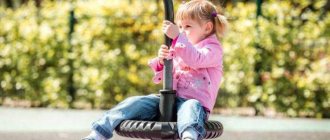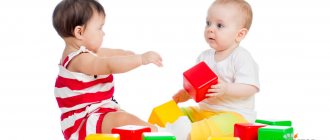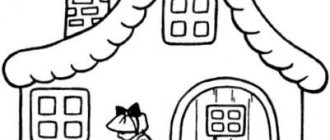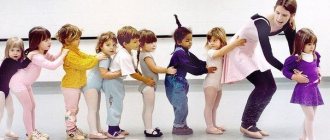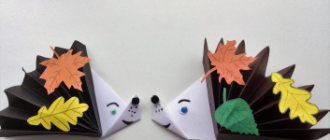Physical education and development of young children
Klochko Olga
Physical education and development of young children
Physical education and development of young children
"Movement is life"
- these words are known to almost every person.
The fact that physical activity is beneficial for the human body is indisputable. But not everyone understands how important it is for the formation physical children to lead an active lifestyle from an early age At home, parents prefer to keep their children busy with quiet games: at best, drawing, intellectual or other board games, at worst, watching TV shows, videos or computer games. And this is quite understandable: parents want to relax after a busy day at work; apartments have a lot of furniture and little space. , and “a child, running away, can get injured or break something. It’s better if he sits – he’ll be calmer.” The role of physical education in the development of a young child is of great importance. The child grows stronger and develops not as a separate , isolated being, but as a future social personality, since it is the knowledge of one’s strengths and the degree of faith in them, acquired in the process of action, that to a large extent determine the social traits of the individual and his position in the environment. Given the role that motor activity plays in a child’s life, the culture of correct movements is one of the main tasks of physical education .
A firm, correct gait, a slender and stable body position, a strong and bold jump, a correct arm swing, fast running, etc. - all these are moments that play an extremely important role in the emergence and strengthening of that feeling of health, vigor and faith in oneself. strength, which is extremely important and valuable in the developing personality of a child. 1. Features of the physical development of young children .
Raising children healthy , strong, and cheerful is the task of every preschool institution. , physical education classes are provided . They should be built in accordance with the psychological characteristics of a particular age , accessibility and appropriateness of exercises. Sets of exercises should provide physiologically and pedagogically necessary and justified load that satisfies the baby’s need for movement, and be exciting. The correct organization of physical education is one of the most essential sections of raising a young child . Physical education of children includes the following tasks: 1. Protection and promotion of the child’s health, normal functioning of all organs and systems of the body;
2. Ensuring timely and complete physical development ;
3. Development of movements;
4. Education of cultural and hygienic skills.
The main means of physical education are :
- proper nutrition;
- correct mode;
- proper feeding, sleeping, toileting and a number of health-improving and hardening procedures;
- creating favorable conditions for a variety of activities and, above all, for the child’s movements.
The importance of these tasks is due to the fact that, despite the rapid growth and development of organs and systems , their activity is still imperfect, the protective properties of the body are poorly expressed, and young children are easily exposed to adverse influences of the external environment. Therefore, it is necessary to promote the correct and timely development of the skeletal system and ligamentous-articular apparatus, the formation of physiological curves of the spine, the development of the arches of the foot , strengthen all muscle groups, promote the development of the cardiovascular system, increase its ability to adapt to different and rapidly changing loads, strengthen the respiratory muscles , promote 4 deepening and rhythmicity of breathing, development of the ability to coordinate breathing with movement, promote the development of the nervous system and sensory organs. At an early age , conditions must be created for varied wakefulness, for motor activity and the development of children’s basic movements . To do this, the group must have appropriate equipment, aids and toys. Thus, children of the second and third years lie with great pleasure and benefit on their stomachs, rolling the car on the carpet; crawling under the arch to put it in the garage; bend over and squat repeatedly while building a path from large, but light (hollow)
bricks, ride down the hill.
Children's need for movement and change is natural. But they themselves, due to insufficiently developed activities (playing, etc., rarely or do not use climbing, jumping, stepping over at all, rarely play with a ball or hoops. Therefore, children should be given tasks that encourage children to make a variety of movements, but at the same time watch , so that children do not get overtired, they can and want to observe their surroundings, engage in activities with toys and building materials. physical education children healthy , strong, and cheerful . Classes should be structured taking into account the psychological characteristics of a particular age , the availability and appropriateness of exercises. Properly selected complexes should provide a pedagogically necessary and physiologically justified load that satisfies the baby’s need for movement, and be exciting. The muscular system in young children is formed on the basis of the development of the nervous system and an increase in the mass of skeletal muscles. Particular attention is recommended to be paid to the development of the arch of the foot , since in the second and partially in the third year of life it is flattened. Therefore, it is very useful to train children in lifting, walking on their toes, walking on an inclined plane and on a ribbed board. Outdoor games and physical education classes should be carried out in a clean, well-ventilated area. The content of the exercises should captivate and interest the child. Taking into account the psychophysiological characteristics of children 2-3 years of age (quick fatigue, imbalance and inconsistency of behavior, etc.), during classes, an adult monitors the correct alternation of the process of excitation and inhibition, does not overload them with monotonous movements, thus ensuring active rest after overload and rapid recuperation. Positive emotions, emotional intensity of activities are the main conditions when teaching children movements . Imitation gives rise to emotions that activate, concentrate the child and, if necessary, for example, in a fun, interesting game, even force him to restrain himself at the right moment. In addition In addition, interest has a positive effect on the motor activity of children , especially those who are sedentary and inert.At this age , the conditional connection between the name of the action (word)
and movement.
The name of the movement must always be accompanied by a display of the action corresponding to this word. Frequent individual communication, support and assistance during classes are necessary for the baby, since attention from an adult evokes positive emotions and is fundamental in working with children of the second and third years of life. Physical education in preschool institutions is based on the systematicity of classes provided for in the “Program of
Education and Training in Kindergarten” and their sequence
(from easy to more difficult material)
.
The baby is gradually taught the correct perception of sound and visual signals and the speed of reactions to them, as well as independence. Performing a new exercise that is taught to a child should cause him some effort, but be accessible to him. Consolidation of acquired skills and their improvement are achieved by methodically repeating movements with mandatory complication (increasing physical activity , varying, changing content).
2. Forms, means, methods and techniques of physical education
Forms of organizing physical education for children include :
— physical education classes;
— physical education and health activities (morning exercises, physical education sessions, hardening procedures)
- daily work on the physical education of children (outdoor games, walks, individual work with children, children’s independent activities with various types of physical exercises , walks).
All these forms, meeting the general objectives of physical education and the comprehensive development of the child , are interconnected. Each of them has its own special tasks, which determine its place in the daily routine of preschool age . Physical education classes: Physical education classes are varied in content. The structure of the lesson consists of children sequentially performing physical exercises . It is determined by the assigned tasks and the performance characteristics of the nervous system and the entire body of the child at each individual stage of age development . Monitoring the dynamics of the state of the child’s body and his psyche during the lesson is one of the main responsibilities of education upbringing depends on this . In order for physical education classes to meet the educational , educational and health goals, they must be interesting and cause a certain emotional uplift in children . Interest in classes in any age troupe is ensured by a certain novelty of exercises and games, a gradual complication of tasks that evoke the work of thought, active action, positive emotions, and the desire to achieve results.
Physical education and health activities include:
morning exercises, physical training sessions, hardening procedures in combination with physical exercise . Morning exercises are an obligatory part of a child’s daily regimen in the family, nursery, or kindergarten. It involves a set of specially selected exercises that have a diverse effect on the body of those involved in order to improve health, develop motor skills and qualities, improve motor abilities taking into account the physical load on the body, it also increases the vital activity of the body, disinhibits the nervous system after sleep, reduces the time of transition from sleep to wakefulness. Morning exercises, influencing the formation of correct posture, deepen breathing, enhance blood circulation, and promote metabolism.
Hardening procedures in combination with physical exercise also play a significant role in physical education and health activities. In preschool institutions, air baths, water procedures and sunbathing are used children Hardening procedures are most effective in combination with physical exercise . Active muscular work helps improve the process of thermoregulation and thereby adapt the body to the surrounding external environment. During the hardening process, a deep restructuring of the body occurs, and if the child is active, it is carried out naturally and simply. Hardening activities in combination with physical exercises that are interesting for the child cause an emotional uplift, increase the functions of nerve centers, and have a beneficial effect on the autonomic nervous system.
3. Forms of organization of children of early preschool age
The health-improving and educational tasks of the physical education program for children are carried out in various forms: outdoor games, walks, individual work with individual children and with small groups, physical education holidays, independent classes.
Outdoor games as the main motor activity of preschool children are planned by the teacher at different times of the day in accordance with the regime of each age group . Outdoor games contribute to the all-round development of children , promote the health of the body, enrich children’s lives with new content , educate their feelings , behavior, orientation in the environment, independence and creative initiative. Physical education holidays in kindergarten are a demonstration of the healthy, cheerful state of children and their achievements in the formation of motor skills. The basis of the physical education holiday program should be fun outdoor games and a variety of physical exercises learned in regular physical education classes; they do not require special training and naturally fit into the holiday program, giving children great pleasure.
4. Physical education
To solve the problems of physical education of children of primary preschool age , various means are used:
hygiene factors, natural forces of nature, physical exercise . In addition, the physical education of children is influenced by movements included in various types of activities (labor, modeling, drawing, designing, playing musical instruments, dressing, washing). These means have different meanings and occupy a certain place in the system of physical education at different stages of human development . Hygienic factors are a unique means of physical education . Compliance with the requirements of personal and public hygiene, activity patterns, sleep, nutrition, and so on. It evokes positive emotions in a person, which in turn improves the functioning of all organs and systems and increases performance. In addition, hygienic factors are a prerequisite for a more effective impact of physical exercise on the body of those involved. Failure to maintain cleanliness of premises, as well as physical education equipment, equipment, toys, clothing, shoes can lead to various diseases in children and reduce the positive impact of physical exercise on their physical development . The natural forces of nature—the sun, air, and water—are important means of promoting health, as well as increasing efficiency. Water cleanses the skin of impurities; the sun's rays kill various microbes, promote the deposition of vitamin D under the skin and protect a person from diseases; the air of gardens, parks, forests, containing special substances (phytoncides, helps destroy microbes, enriches the blood with oxygen. The use of natural forces of nature in combination with physical exercise is most beneficial for the child’s body.
5. Contents of work on physical education of young children
In the process of physical education, one becomes familiar with the most rational ways of performing movements that have a positive effect on the functioning of all organs and systems. Properly organized physical education contributes to the formation of a good physique, the prevention of diseases, and the improvement of the functioning of internal organs and systems of the child’s body. In this regard, the physical education of young children is based on an individual approach to the child and play, where the very value of preschool childhood is preserved and where the very nature of the preschooler is preserved. Positive emotions and emotional saturation of classes are the main conditions for teaching children movements . Imitation gives rise to emotions that activate the child. Mastering movements also has a good effect on children's speech development . The understanding of adult speech is improved, and the vocabulary of active speech is expanded. In addition to traditional ones, in joint activities with children I use gaming, recreational and role-playing types of physical education activities. Play is one of the most important means of physical education for preschool children . It promotes the physical , mental, moral and aesthetic development of the child . Various movements and actions of children during play, with skillful guidance, effectively influence the activity of the cardiovascular, respiratory and other body systems, stimulate appetite and promote sound sleep. With the help of outdoor games, the child's comprehensive physical development . During games, preschoolers develop and improve various skills in basic movements (running, jumping, throwing, climbing, etc.)
A quick change of environment during the game teaches the child to use the movements he knows in accordance with a particular situation.
All this has a positive effect on improving motor skills. In the fresh air, you can play games of any mobility with running in different directions, throwing a ball at a distance and at a target, and jumping. The child’s physical activity is increased throughout the day by creating an appropriate environment, selecting physical education aids and toys, and encouraging children to use them . In physical education, a strict differentiated approach is observed: when selecting games and physical exercises , their dosage takes into account the age , health status, physical development and preparedness , as well as the individual characteristics of the child. In young children , develop and improve motor skills in basic types of movement: walking, running, balance, climbing, throwing and jumping. Active recreation (physical education holidays and
entertainment , Health Days) .
The colorful appearance, accessibility, lack of strict regulation of the activities of participants, the possibility of a wide manifestation of emotions and individual abilities make such events very popular among preschool children and their parents .
Conclusion
Our state pays great attention to the physical education of children of all ages . The program sets one of the most important tasks - the physical education of a strong young generation, starting from a very early age . Therefore, one should pay attention to the development of children from an early age and begin physical education from early childhood , introducing all this into the norm. Early age is a period of rapid formation of all psychophysiological processes . Timely started and correctly carried out education of young children is an important condition for their full development , and properly organized physical education contributes to the formation of a good physique, the prevention of diseases, and the improvement of the functioning of the internal organs and systems of the child’s body. Considering that the necessary effect in the proper physical education of a child comes from the direct influence of adults on him, in the process of independent activity, as well as under the influence of information coming from the environment, it is impossible not to say about the huge role of the teacher in this process i.e. j. children spend more time in preschool. The task of the teacher when carrying out work on the physical education of children is to systematically implement interrelated health, educational and educational tasks , the implementation of which ensures physical development , strengthening the child’s health, acquiring the correct motor skills, nurturing an emotionally positive attitude towards physical education and sports, and the comprehensive development of his personality . The peculiarities of the physical development of young children require deep knowledge and a creative approach from the teacher, as well as strict regulation of the motor activity of children in the organization of outdoor games, physical education classes, and morning exercises. Therefore, when planning and conducting work on physical education the teacher must take into account the age-related anatomical and physiological characteristics of the child’s development and the characteristics of the development of movements , and create all the conditions for the normal physical development of children . Thus, the physical education of children of this age is of great importance for the future of the entire society and its goal is to create all the necessary and favorable conditions for the future formation of a healthy and physically strong personality .
Age-related characteristics of physical activity in children
5-6 months. Already from birth, the child needs to create all the conditions conducive to voluntary movements and play activities. Since physical activity is very closely related to the development of the central nervous system in children. Therefore, it is necessary to encourage and stimulate motor movements from the first year of the baby’s life. For example, give a rattle in your hands so that the child learns to hold it and consciously release it with his fingers.
6-7 months. By this moment, the children are already like a small motor and they begin independent vigorous activity, they begin to crawl. But don’t be alarmed if your baby is lazy and doesn’t like moving independently on all fours. Even those children who skip the crawling stage and immediately move on to the walking stage by the age of one year or a little later also turn out to be very physically active and quickly catch up with their crawling counterparts.
From 1 year to 2 years. During this period, children improve their development of basic movements and gradually move from walking to running. Also, during this period of time, correct posture is formed, the arch of the foot acquires a clearer outline, and coordination skills and a sense of balance begin to appear.
From 2 years to 3 years. During this period, babies improve their throwing, climbing and crawling skills. Therefore, various ball games for this age are very entertaining and useful. For example, to develop accuracy and the skill of hitting a target, place a small basket in front of your baby and ask him to throw a ball into it.
From 3 to 4 years. As a rule, during this period, babies develop movements reminiscent of jumping. After perfecting this skill, they move on to jumping in a forward direction. Also, three-year-old children love to actively climb all kinds of steps. Therefore, it is necessary to provide conditions for free climbing and climbing over obstacles.
In order for the child to successfully consolidate all his motor skills, it is recommended to conduct classes in a group of similar peers. For example, in a children's entertainment complex, where there are slides, sports walls with crossbars, balls, etc. This allows the child to perform various movements.
